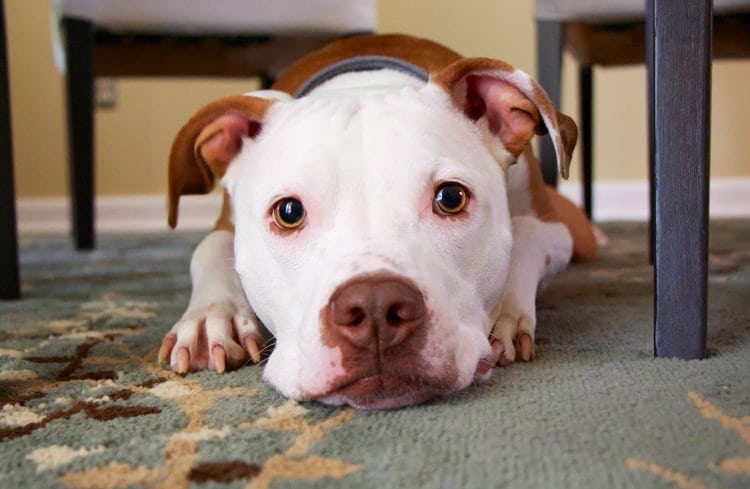There was a time when dog’s ears came in only one size and shape just like those of their wolf ancestors.
This natural ear shape has a flap or pinna that is erect and highly mobile, well-insulated with hair on the outside and very smooth on the inside.
When we began to breed dogs to suit both our practical purposes and aesthetic preferences, we created the fantastic variety of ear shapes and sizes that dogs have today.
The most obvious changes made by breeding are those that have affected the shape or size of the ear.
In changing the design of the dog’s ear, however, we have increased the risks and the incidence of ear problems.
Ear problems are among the most common reasons why dog parents visit vets. Common issues include hearing issues and deafness.
A dog’s hearing is remarkable. While some dog’s ears are better tuned than others, most dogs can hear a sound four times farther away than humans.
They can detect and locate the source of the sound in six-hundredths of a second. Dogs can also distinguish sounds that are particular to their owner from the multitude of sounds all around them – often from the depths of sleep.
Dog Hearing Loss
Deafness refers to either the lack or loss of the ability to hear. It can be complete or partial. It can also be unilateral if it affects only one ear or bilateral if it affects both ears.
Deafness is particularly disturbing for a dog and its owner because it eliminates an important form of communication between people and dogs. However, with effective training, deaf dogs can easily learn to understand and respond to sign language.
Dogs can be either born deaf or lose their hearing as a result of a plethora of causes. Therefore deafness can be divided into congenital and acquired.
Congenital deafness
Deafness existing from birth is caused early in fetal development when the sound receptor cells in the ear fail to form properly. All pups are born deaf, but should gain hearing within two weeks.
Unfortunately, some puppies never develop hearing ability. Breeders and owners are usually unaware of this issue until training sessions begin.
Recently it has been shown that a link exists between congenital deafness and the genes for the color of the dog’s coat. This suggests that some breeds are more prone to deafness than other. Accordingly, over 30 breeds of dog are at risk from congenital deafness in one or both ears.
Predominantly white dogs and dogs with merle coats are particularly prone. Genetic evidence suggests that this form of deafness is associated with the color of the coat and is linked with either the merle or the piebald gene.
Breeds with the merle gene include:
- Collies
- Shetland Sheepdogs
- Dachshunds
- American Foxhounds
- Old English Sheepdogs
- Norwegian Dunkers
Dog breeds with the piebald gene:
- Dalmatians
- Beagles
- Bulldog
- Samoyeds
- Bull Terriers
- Bulldogs
- English Setters
- Greyhounds
- Sealyham Terriers
- Great Pyrenees.

Acquired deafness
Most causes for deafness in dogs can be prevented, but sadly the majority of dog owners lack the appropriate education.
Many vets and other pet related websites warn about certain popular conditions among dogs while neglecting to pay attention to the reasons that lead to deafness.
The most common reasons for acquired deafness are:
Ear infections – Dogs can lose their hearing as a result of chronic infections of the middle and inner ear that cause tissue damage. The most common cause for ear infection is moist ear canal.
Learn how to properly take care of your dog’s ears and prevent such issues. If you cannot maintain your dog’s ears, learn the signs of ear infection, s you can take your dog to the vet as soon as possible.
Drugs and toxins – Deafness may be a consequence of a drug’s toxicity. Antibiotics such as neomycin sulfate and gentamicin that are used to treat ear infections can damage the hearing nerves.
Other deafness-causing drugs include antiseptics and chemotherapy drugs. Dogs can also lose their hearing due to exposure to heavy metals like lead, arsenic, and mercury.
Diseases – Certain diseases can cause partial hearing loss or even complete deafness. For example, the canine distemper leads to impaired hearing ability.
Traumas – Traumas like head injuries, puncture wounds and even loud noises or frequent exposures to loud noises can damage the ear drum and cause deafness.
Tumors – Less commonly, as with humans, some types of tumors in the inner ear or brain, may cause deafness by pressuring and damaging the auditory apparatus or nerve.
Hormonal disorders – Hypothyroidism induces abnormal nerve function which also impacts the auditory nerve.
Wax build-up – Accumulating too much wax within the ear may lead to temporary deafness. Basically, any condition that reduces the diameter of the ear canal or blocks the normal movement of sound to the eardrum leads to some degree of impaired hearing.
Geriatric deafness – Deafness resulting from old age is physiological and quite common. It is a gradual process that starts around ten years of age.
How to Tell If Your Dog is Deaf
Most owners usually struggle to decide whether their new four-legged fur baby is deaf or merely cool enough to ignore them and their commands.
Since deafness affects your pup’s safety, it is essential to know the severity of the hearing loss you are dealing with. Unfortunately, there is no method for thoroughly testing your puppy’s hearing abilities at home.
However, some techniques can be used as helpful indicators. These include:
1. Consider your puppy’s breed.
As previously mentioned, certain breeds are at higher risk of being born deaf. Keep in mind, that if your puppy does not belong to a group of predisposed breeds, it does not mean it cannot suffer from congenital or acquired deafness.
2. Pay attention to your puppy’s bite.
If your puppy plays rough and bites harder than its littermates, it may be because it is deaf. If the puppy is not able to hear its littermates’ squeals, it does not receive any indicators that it is too rough and simply fails to back off.
3. Feeding response.
If your puppy is deaf, he is likely to be the last in the litter to feed, simply because it is unable to hear the feeding bowls or the rustle of the food bag.
4. Check your dog’s ear movements.
Try noticing whether your dog’s ear move when you call its name. Hearing dogs move their ears in order to localize the sound source. Those movements include pricking the ears up or twitching the ears aside. If your dog is deaf its ears will not be as mobile.
5. Notice changes in habits and tendencies.
If your dog stops waking up when you enter the room or come home from work it may be a sign of hearing problems. Another sign is if your dog stops being afraid of loud sounds like fireworks, thunderstorms, the lawn mower or the vacuum cleaner.
6. Test your dog’s hearing.
To test your dog’s hearing at home, you do not need any sophisticated and complicated methods. You can perform a hearing test by simply banging two pan lids together, clapping your hands, jiggling your keys or blowing whistles behind your dog or from a position he cannot see you and wait for a corresponding reaction.
As a trigger, you can also turn on the vacuum cleaner or open a jar of biscuits.
Another form of testing is to walk your dog past a house with a barking, aggressive dog inside. That way, your dog will not be able to see the other dog, only hear it.
As you pass by and the other dog starts barking, look for any kind of reaction from your dog, usually defensive barking or growling. A well trained dog may ignore the barking, but in most cases it is reasonable to expect some form of reaction.
When testing your dog’s hearing abilities, it is important to remember that most auditory cues are accompanied by visual or physical stimuli.
Therefore you need to make sure your dog cannot see or feel what you are doing. For example, if he can feel the breeze of the pots banging on his whiskers or feel the vibrations of the vacuum cleaner on the ground, he may give a false positive answer to the test.
The other problem with home-conducted hearing tests is that they are useless if you dog is deaf only in one ear. In that case he will be able to hear the sound but probably unable to locate the sound’s source. The inability to locate the source of a sound is considered to be the only true behavioral symptom of deafness.
7. Be aware of other signs.
Other signs that may indicate hearing issues include – head shaking, pain when touching the ears, odorous discharge from the ears, excessive barking, decreased activity, nervousness and tendency to bite when approached from the back.
8. The BAER test.
More often than not diagnosis can be made by observation alone.
However, the only way to definitively diagnose deafness or hearing loss is through the BAER (brain-stem auditory evoked response) test.
The BAER test is a technical procedure, performed by specialist vets, to determine whether a dog is clinically deaf.
The BAER test is designed to assess the hearing in both ears, and it usually lasts for 10-15 minutes.
It detects various levels of hearing function and loss and can be performed in all dogs and puppies older than 6 weeks.
The test records the electrical activity in the cochlea and the auditory pathways in the brain. It is painless and easy to perform on a relaxed dog.
If the dog is agitated and nervous, it requires anesthesia. Tiny electrodes placed under the skin of the scalp are linked to a computer that sends signals to the dog via foam insert earphones. The interpretation of the results requires certain amount of experience and the testing itself is relatively expensive.
Usually, before conducting the BAER test, the veterinarian will take your dog’s complete history and perform a thorough physical and behavioral examination.
If your dog needs to be anesthetized for the BAER test, your veterinarian will also take a blood and urine test, an EKG and take radiograph images of your dog’s heart and lungs, as precaution measures.
Dog Hearing Loss Treatment
Sadly, there is no realistic treatment for deafness in dogs, especially in cases of congenital deafness.
Dogs suffering from temporary hearing loss provoked by ear infections, tumors or build-up of wax can be treated by medically or surgically removing the causative agent.
Even in these cases the treatment is not 100% successful and it depends on the severity of the already caused damage.
All in all, in most cases, deafness is irreversible and permanent. Some highly specialized veterinary hospitals offer customized hearing aids for disabled dogs, but these are not only extremely expensive but inefficient for most causes of canine deafness too.
Most deaf dogs live happy and fulfilling lives. You just need to put some extra effort into keeping them safe. For example, always keep your deaf dog on its leash.
With patience and using treats with strong odors, give flamboyant but straightforward hand signals to train your dog to come, sit, stay and lay down.
A deaf dog’s other senses usually become more acute.
You can use floor vibrations or a flashing light to get its attention. The most natural way for a deaf dog to cope with its disability is by having a hearing companion. Your deaf dog understands what is happening by watching the body language of its buddy.
It is essential to understand that deafness is not something you can visualize on the outside.
Deaf dogs have no apparent physical defects. Besides the fact that they have a justified excuse for not obeying their owners, deaf dogs are pretty normal.
Therefore understanding deafness in dogs, as well as learning how to recognize its early signs is of paramount importance.
Preventing the causes that may lead to deafness and taking your dog to the vet as soon as you notice something abnormal are the best ways to help your fur baby.

